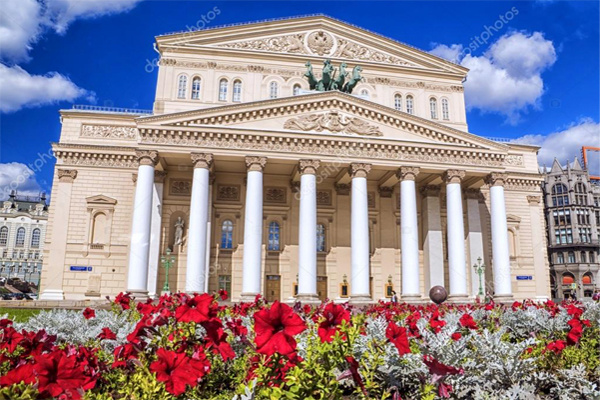
The Bolshoi Theatre has always been, and will remain, one of the main symbols of Russia and its culture. It is Russia’s main national theatre, a bearer of the traditions of Russian music culture and a centre of world music culture, the spearhead of the development of the country’s performing arts.
The history of the Bolshoi began in 1776. The first permanent theatre company in Moscow was established by Prince Peter Urussov, Public Prosecutor in Catherine II’s imperial government and a passionate lover of theatre, together with an English impresario, ex-acrobat Michael Maddox. In 1780, Prince Urussov, having undertaken to construct an edifice "of which the external ornamentation will contribute to the beauty of the city", built a theatre in Petrovka Street which became known as the Petrovsky Theatre, where the company performed drama, opera and ballet.
Twenty-five years later, this building burnt to the ground in one of the fires which were common occurrences in the Moscow of that time. Performances were given in different parts of the town until, in 1825, a new theatre opened on the site of the one that had burnt down. Designed by architects Osip Bovet and Andrei Mikhailov in classical style, the building had a portico of eight Doric columns, surmounted by a pediment of Apollo driving a chariot drawn by four horses. Dramatic performances were transferred to the recently opened Maly Theatre, while the Bolshoi Petrovsky Theatre, as it was then known, specialized in productions of opera and ballet. At the time, the Ballet Company had only 47 dancers.
In 1853, the Theatre’s interior was destroyed by fire and the building was restored by the Venetian architect, Alberto Cavos, son of the composer Caterino Cavos and grandfather of Alexander Benois. In 1856, the Bolshoi Theatre once again opened its doors to the public. Since then, there have been no major external changes to the building.
From early on, the Bolshoi offered its audiences productions of operatic masterpieces ranging from Mozart’s The Magic Flute to works by Spontini and Boieldieu, Rossini and Auber, Bellini and Donizetti. Presented in counterpoint to the European mainstream, were the first musical vaudevilles of Fomin and Pashkevich, and likewise Verstovsky’s first romantic operas. As distinct to Petersburg which opted for a foreign repertoire, the Moscow Bolshoi Company willingly made its stage available to Russian composers. It was in Moscow that Tchaikovsky’s Mazeppa and Eugene Onegin first saw the light of day, that state occasions were invariably celebrated by performances of Glinka’s A Life for the Tsar, and that Mussorgsky’s Boris Godunov and Borodin’s Prince Igor were given ideal dramatic form. An essential component of every production was the emphasis on acting, which has always been an inherent part of the Bolshoi style, as well as the effective decorative treatment provided by the designers.
The first ballets to be produced were by French and Italian ballet masters such as Filippo Beccari, the Morelli brothers and Jean Lamiral. Before long, however, young Russian choreographers such as Adam Glushkovsky took over, concentrating on ballets with Russian themes. From 1820-1830 the company, now expanded to 150 dancers, developed in the French tradition under the influence of Félicité-Virginie Hullin-Sor and Fanny Elssler who familiarised the Moscow public with works of Jules Perrot and other masterpieces of romantic ballet. Marius Petipa's Don Quixote which received its premiere in Moscow on 26 December 1869 was acknowledged to be the visiting card of the Moscow Company, a work which, infringing all Imperial Theatres traditions, had transferred from Moscow to Petersburg. Alexander Gorsky, Petipa's assistant and pupil, was appointed to the Bolshoi Theatre in 1900 and from then on until his death in 1924, he revised the company's staging of the basic repertoire, making them more dramatic and realistic and laying the foundations for the company's great future successes.
Following the October Revolution in 1917 left-wing critics demanded the removal from the repertoire of classical works. However more moderate voices prevailed and, during the Soviet period, traditional nineteenth-century operas and ballets were performed alongside contemporary works.
With the transfer of the capital from Petrograd to Moscow, the Bolshoi became the country’s first theatre, a repository of the best creative talents. The great singers and dancers were working at the Bolshoi as well as the great conductors, choreographers, directors and stage designers. Sets by Vladimir Dmitriev, Fyodor Fedorovsky, Pyotr Williams, Simon Virsaladze are not only the applied objects, but the great paintings. Boris Pokrovsky renovated the opera staging. Leonid Lavrovsky and Yuri Grigorovich enabled “the golden age” of Soviet ballet. Amongst the singers glorified the Bolshoi were Antonina Nezhdanova, Nadezhda Obukhova, Maria Maksakova, Irina Arkhipova, Tamara Milashkina, Elena Obraztsova, Galina Vishnevskaya, Makvala Kasrashvili, Feodor Chaliapin, Leonid Sobinov, Sergei Lemeshev, Ivan Kozlovsky, Evgeny Nesterenko, Vladimir Atlantov.
Olga Lepeshinskaya, Marina Semenova, Galina Ulanova, Maya Plisetskaya, Natalia Bessmertnova, Ekaterina Maximova, Nina Timofeyeva, Asaf Messerer, Alexei Ermolaev, Mikhail Lavrovsky, Vladimir Vasiliev, Maris Liepa were among the great principal dancers of the 20th century.
The Bolshoi orchestra too has always won recognition for the Theatre – it stands comparison to any of the world’s leading symphony ensembles—as have its conductors amongst whom were Sergei Rachmaninov, Vyacheslav Suk, Nikolai Golovanov, Ary Pazovsky, Yury Fayer, Samuil Samosud, Vasily Nebolsin, Alexander Melik-Pashaev, Kirill Kondrashin, Boris Haykin, Evgeny Svetlanov, Gennady Rozhdestvensky, Mstislav Rostropovich, Yuri Simonov, Alexander Lazarev, Mark Ermler.
Today’s Bolshoi combines a pride in its artistic heritage with an awareness that it must grow and develop to prosper in today's rapidly changing world. The Bolshoi presents to its public as chef-d’oeuvres of Russian and western 19th-20th century music theatre, as specially commissioned works. Today’s Bolshoi Ballet artists, Svetlana Zakharova, Ekaterina Krysanova, Olga Smirnova, Vladislav Lantratov, Artem Ovcharenko, Semyon Chudin, Denis Rodkin, and others ensure that the Bolshoi’s standards are held as high as ever. In March 2016, Makhar Vaziev, former director of the Mariinsky and La Scala Ballet, was appointed Ballet Director. Since February 2014, Maestro Tugan Sokhiev is Music Director and Chief Conductor of the Bolshoi Theatre.
Now the Bolshoi Theatre has three stages at its disposal: its legendary Historic Stage, the New Stage, and the Beethoven Hall; in 2018/2019 opera company of the Boris Pokrovsky Chamber Theatre became the part of the Bolshoi, the theatre received the name of Boris Pokrovsky Chamber Stage; more than 500 performances are given per season. Both Opera and Ballet Companies have engaged in extensive touring schedules, appearing in Russian towns and at the world’s most prestigious opera-houses.Today's Bolshoi is not just a theatre with a history going back 245 years; it is a theatre of the 21st century.

